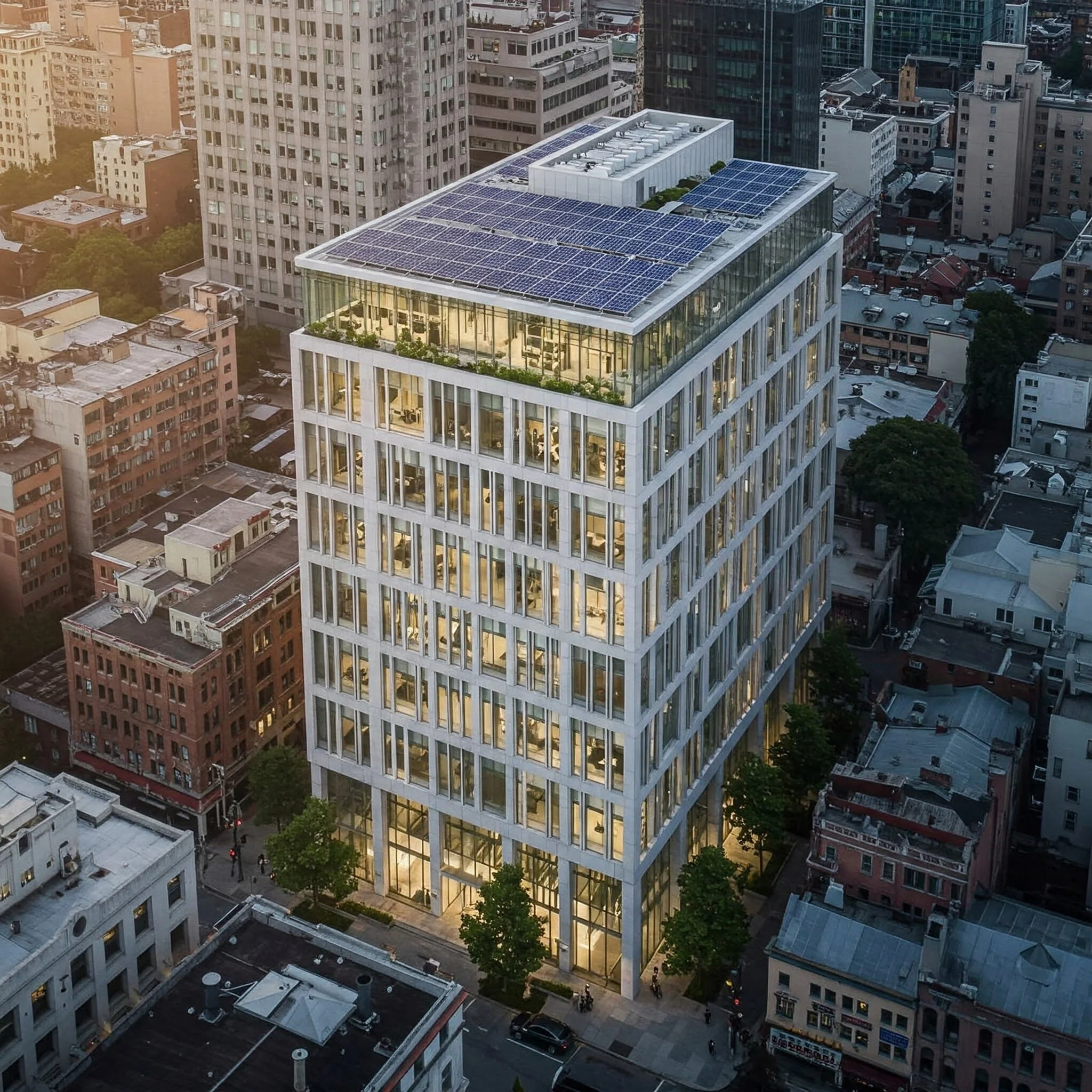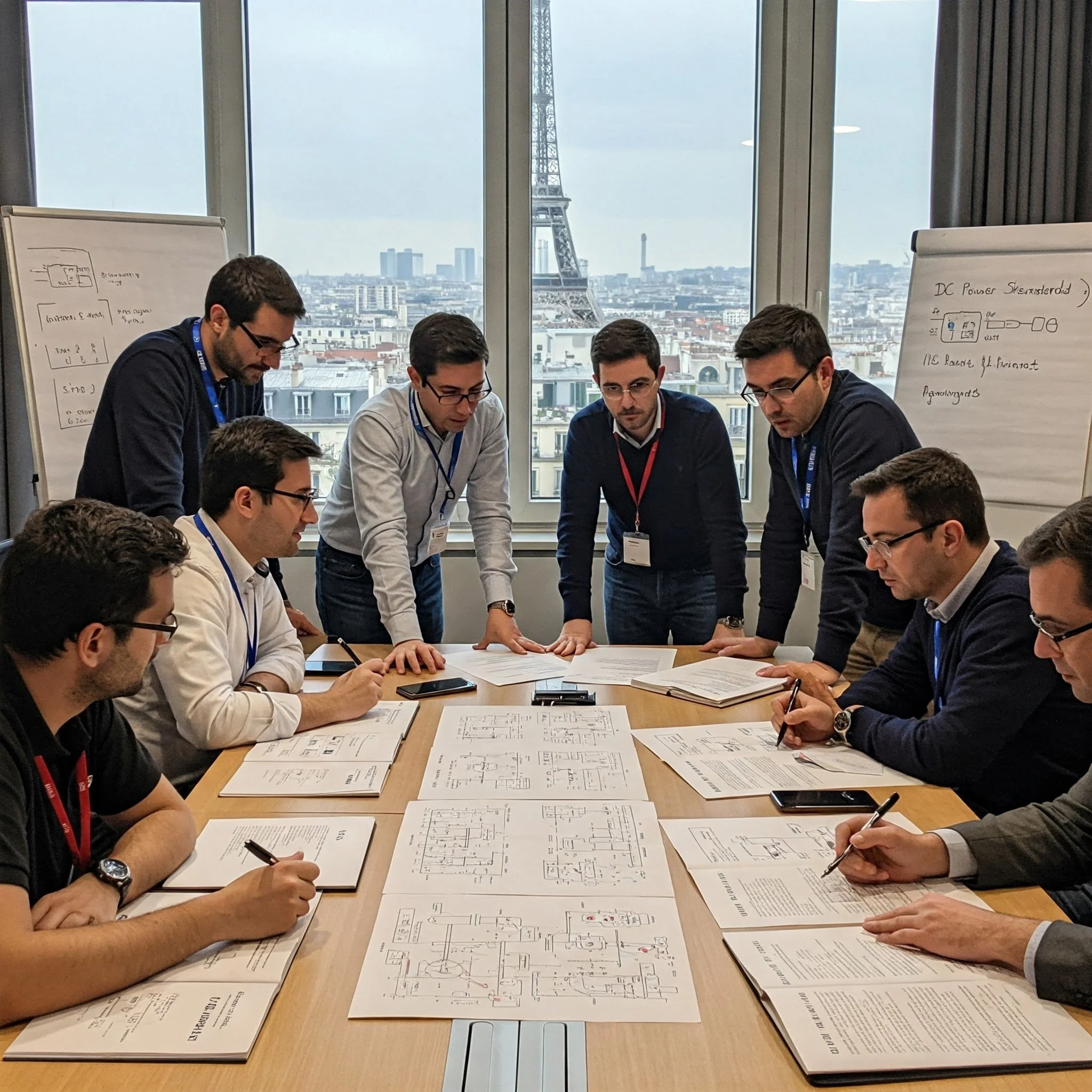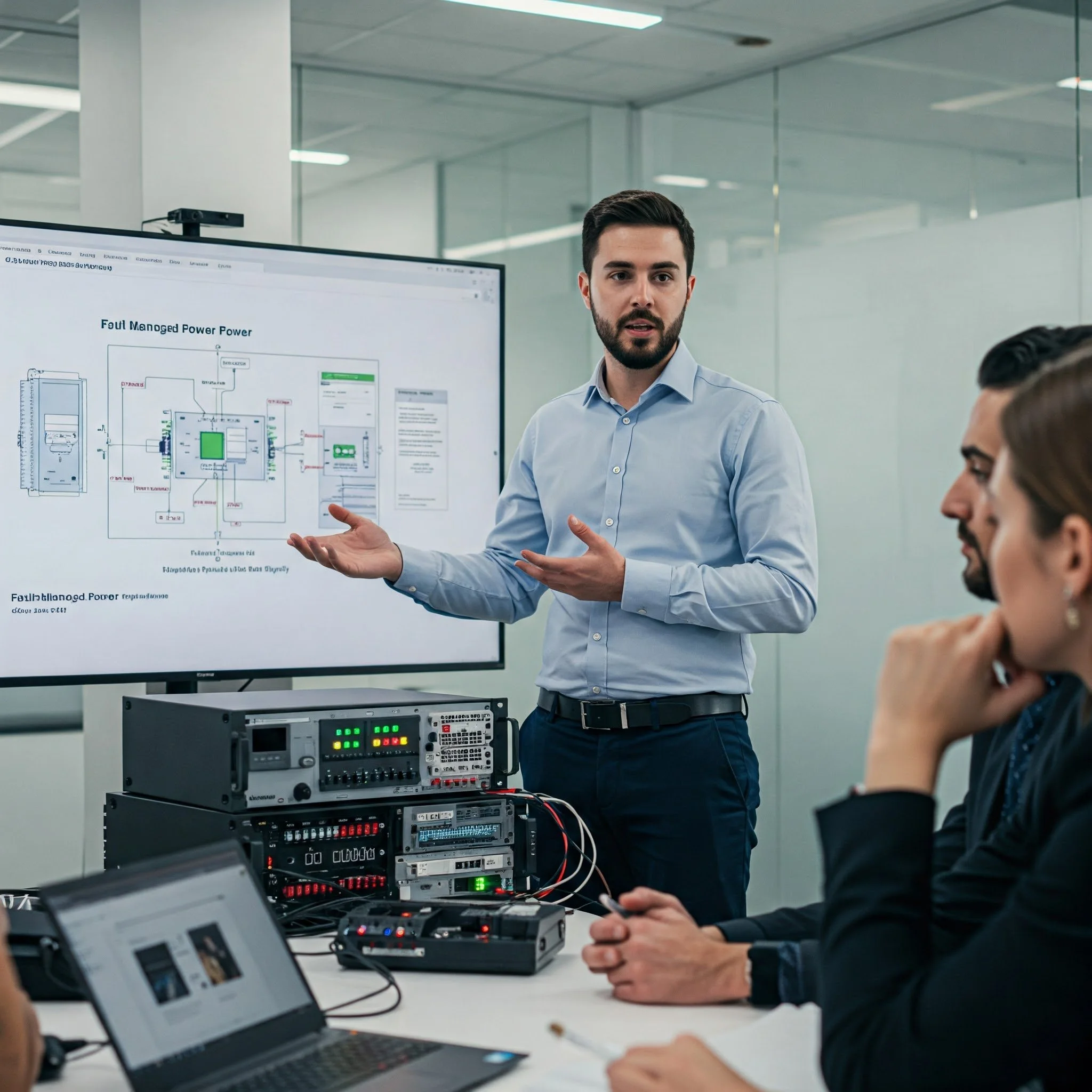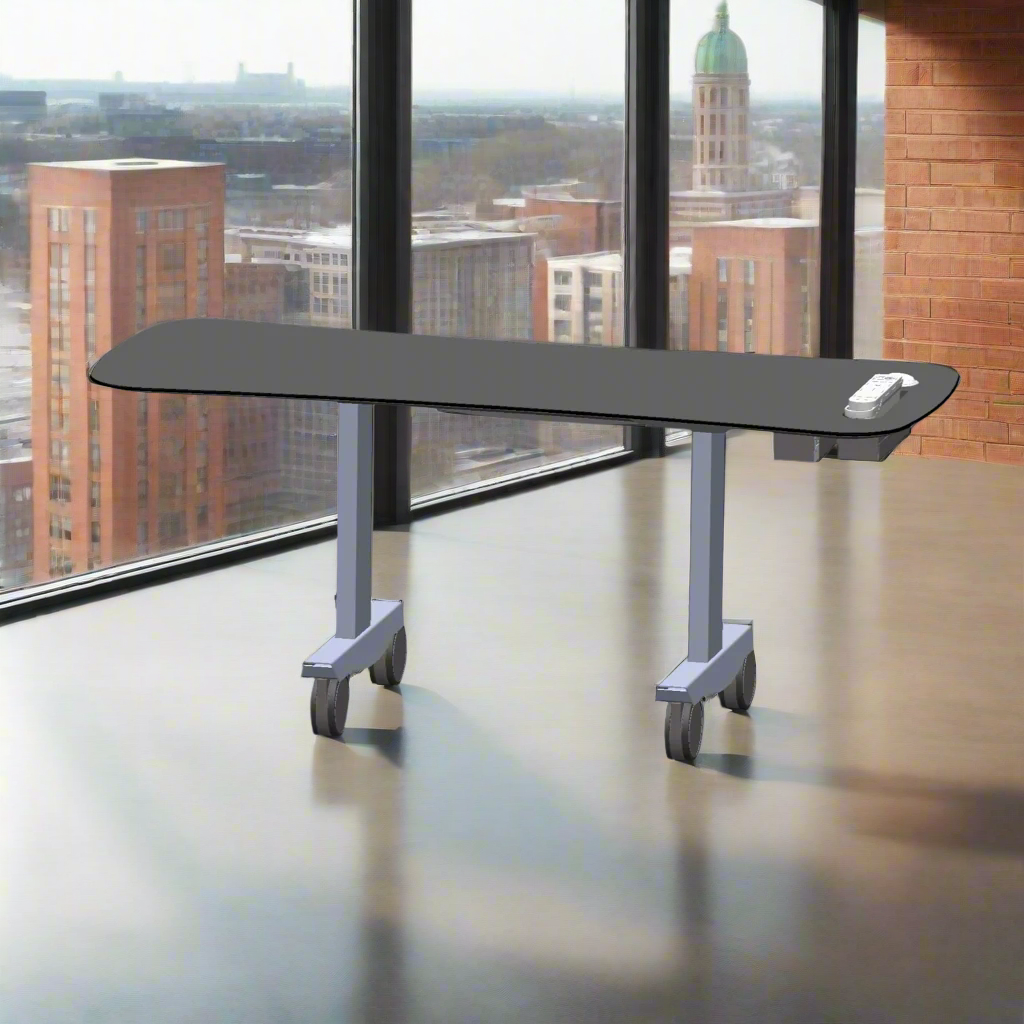The DC Imperative: Powering the Next Paradigm of Built Environments
Unpacking the Convergence of Distributed Energy, Advanced Power Management, and Dynamic Spatial Configurations
NOTE: Stanford University’s STORM AI Tool assisted in the creation of this post. It compiled and organized information from 20 sources.
By Robert Kroon
Summary
An intelligent retrofit can make almost any building “smart”.
The convergence of onsite power generation, fault-managed power (FMP), and battery-integrated agile furniture represents a significant paradigm shift in the architectural and engineering design of direct current (DC)-powered buildings, addressing extant technical limitations in energy distribution and the dynamic configuration of work environments.
The increasing prevalence of renewable energy sources and a concomitant emphasis on ecological sustainability are driving the escalating relevance of direct current (DC) electrical systems. This transition offers the dual benefits of enhanced energy efficiency and improved resilience against grid-based power disruptions while concurrently accommodating the evolving demands of contemporary work paradigms.[1][2]
Onsite power generation has gained considerable traction as a robust alternative to conventional alternating current (AC) infrastructure, enabling buildings to leverage renewable resources such as solar photovoltaic and wind energy. This decentralized approach substantially mitigates reliance on centralized grids, thereby augmenting energy autonomy and overall efficiency through the reduction of transmission losses inherent in extensive distribution networks.[3][4]
Concurrently, fault-managed power (FMP) systems enhance electrical safety and operational reliability through proactive monitoring and intelligent management of electrical faults. This capability facilitates rapid fault isolation and remediation, thereby improving system uptime and overall operations performance.[5][6]
The integration of battery-powered agile furniture introduces an innovative dimension to workspace adaptability, allowing organizations to rapidly reconfigure spatial layouts without the constraints imposed by traditional fixed wiring. This facilitates enhanced mobility and flexibility in office design, supporting diverse work methodologies and diminishing the necessity for extensive and resource-intensive electrical retrofitting, thus contributing to more sustainable building practices.[7][8][9][10]
Despite the demonstrable advantages, the widespread implementation of DC-powered systems is not without its challenges. Substantial initial capital investment, issues of interoperability with existing AC infrastructure, and the imperative for the development of standardized protocols constitute significant impediments that necessitate strategic navigation by relevant stakeholders to fully capitalize on the potential of these technologies..[11][12]
Notwithstanding these challenges, the ongoing advancement and increasing acceptance of onsite power generation, fault-managed power systems, and battery-integrated solutions are poised to fundamentally reshape the future landscape of building energy systems, ushering in an era characterized by enhanced efficiency and unprecedented adaptability in both energy management and workspace design.[13][14]
Onsite Power Generation
A crucial part of an intelligent building retrofit is to generate all or some of the power used locally.
Onsite power generation has emerged as a critical distributed energy resource, offering a salient strategy for mitigating the escalating reliability and efficiency challenges inherent in contemporary electrical infrastructure. This growing prominence is principally motivated by an increasing demand for enhanced resilience against localized and regional power disruptions, events frequently exacerbated by the growing frequency and intensity of severe meteorological phenomena, the escalating sophistication of cyber threats targeting critical infrastructure, and inherent vulnerabilities within the interconnected bulk power grid[1].
Furthermore, in parallel with the global transition towards decarbonized energy portfolios, traditional fossil-fueled onsite generation systems are anticipated to experience continued proliferation in specific contexts. For end-use consumers, these localized generation assets provide significant economic and operational advantages by bolstering energy independence, thereby reducing exposure to the systemic risks and volatile pricing structures associated with sole reliance on centralized grid infrastructure[1]. This localized generation capacity can also offer critical backup power during grid outages, ensuring operational continuity for essential services and processes.[1].
Advantages of Onsite Generation
The strategic implementation of distributed generation, encompassing both thermal and renewable energy technologies, yields significant enhancements in both the efficiency and reliability of energy utilization at the point of consumption. Discrete onsite power generation technologies employing thermodynamic cycles such as simple gas turbines or reciprocating engines can achieve net energy conversion efficiencies that demonstrably surpass those of centralized electric grid systems by a margin of 10% to 20%. This is in contrast to the average operational efficiency of extensive electrical grids, which typically ranges between 40% and 45%[2][3]. This improvement in energy efficiency is fundamentally predicated on the elimination of inherent energy losses associated with long-distance electrical power transmission and the avoidance of cumulative inefficiencies arising from multiple voltage transformation stages between centralized generation facilities and end-use loads.
Furthermore, the integration of renewable energy sources, such as solar photovoltaic (PV) arrays and small-scale wind turbines, into onsite generation portfolios offers additional pathways to enhance energy independence and reduce reliance on fossil fuel-based generation. Solar PV systems directly convert solar irradiance into electricity with efficiencies that continue to improve, offering a predictable and distributed energy resource, particularly during daylight hours. Similarly, wind turbines located onsite can harness local wind resources to generate electricity, providing a complementary renewable energy source that can operate independently or in conjunction with other generation technologies. The intermittency of solar and wind resources can be mitigated through strategic sizing, energy storage solutions (such as batteries, as previously mentioned in the context of agile furniture), and intelligent grid integration, allowing for a more stable and reliable onsite power supply.
Moreover, the inherent thermodynamic processes of fossil fuel-based onsite power generation produce thermal byproducts, specifically waste heat, which can be effectively captured and repurposed for secondary thermal applications such as space cooling via absorption chillers, domestic water heating, or industrial process heating. The synergistic integration of electricity generation and heat recovery constitutes a Combined Heat and Power (CHP) system, which can substantially augment overall energy system efficiency, potentially exceeding 80% when both electrical and thermal outputs are considered[3].
This holistic approach to energy utilization maximizes the primary energy input, leading to reduced fuel consumption and lower greenhouse gas emissions per unit of useful energy delivered. The integration of solar thermal systems can further enhance the thermal energy portfolio of a building, providing direct heat for various applications without the need for electricity generation as an intermediary step.
Beyond the operational and environmental benefits, the increasing temporal and dynamic volatility of electricity pricing structures, driven by factors such as the implementation of time-of-use (TOU) tariffs and real-time pricing mechanisms reflecting peak demand periods, positions onsite power generation as a strategically advantageous economic instrument. By enabling end-users to generate electricity locally – whether through dispatchable thermal generators, predictable solar PV output during peak pricing hours, or wind generation when available – organizations can effectively mitigate exposure to elevated energy costs associated with peak demand consumption[1]. This capability transcends the conventional perception of onsite generation as a mere contingency measure for power outages, transforming it into a proactive economic strategy that actively contributes to tangible reductions in daily operational expenditures and enhances budgetary predictability through reduced reliance on fluctuating grid tariffs. The inclusion of renewable energy sources in this strategy can further hedge against fuel price volatility associated with traditional thermal generation.
The Role of Class 4 Power Solutions
Ask your electrical contractor to explain the benefits of DC power.
Recent advancements, particularly in Class 4 power systems, are revolutionizing onsite power generation and distribution within buildings. These systems are designed to deliver both DC and AC power efficiently, addressing the unique energy needs of modern infrastructures[2][4]. By adopting low-voltage DC power distribution, commercial buildings can significantly reduce energy wastage, improving overall sustainability and lowering carbon emissions[4].
Class 4 systems facilitate the seamless integration of renewable energy sources, making them an attractive option for buildings aiming to enhance their energy profiles while adhering to sustainability goals[2]. As the demand for flexible and efficient energy solutions increases, these innovative systems position onsite generation as a key component in the future of power distribution.
Fault-Managed Power
Fault-Managed Power (FMP) systems constitute a significant paradigm shift in electrical power distribution methodologies, engineered to substantially augment the safety, operational reliability, and energy efficiency of electrical infrastructure. Characterized by their proactive monitoring and intelligent management of fault conditions within electrical networks, FMP systems establish a more resilient and consistent power delivery architecture.
This enhanced power integrity translates to tangible improvements in operational performance metrics and safety protocols across a diverse spectrum of applications, encompassing sectors ranging from advanced building construction and critical infrastructure to sensitive information technology installations and industrial automation[5].
Standardization and Classification
Engineering professionals worldwide are working diligently to establish DC power standards. DC-powered buildings are one of the few solutions to the electricity shortages anticipated from the construction of AI Data Centers. Discover the groundbreaking initiatives of Current/OS and see how they are making a difference!
In 2023, a significant regulatory milestone was achieved in the United States with the formal recognition of fault-managed power (FMP) systems within the National Electrical Code (NEC). This acknowledgment materialized through the introduction of Article 726, which specifically delineates a new Class 4 power circuit rating designed to accommodate the unique operational characteristics of FMP technology.
This dedicated classification permits the safe operation of electrical circuits at significantly elevated voltage thresholds, extending up to a maximum of 450 volts. This stands in notable contrast to the operational constraints of the previously established Class 2 and Class 3 circuits, which are subject to more restrictive limitations, specifically a maximum apparent power of 100 volt-amperes (VA) and a voltage ceiling of 300 volts, respectively.
The increased voltage capacity afforded by the Class 4 designation in FMP systems translates directly into a substantially enhanced power delivery capability. Consequently, Class 4 circuits exhibit the potential to transmit significantly greater power levels to connected devices and over extended distances compared to conventional low-voltage power distribution methodologies, such as Power over Ethernet (PoE) systems.
Empirical analyses and theoretical projections suggest that Class 4 FMP systems can potentially achieve a performance envelope up to an order of magnitude, or approximately 20 times, that of traditional PoE in terms of either the total power delivered to remote loads or the permissible transmission distance without incurring excessive line losses. This enhanced power delivery capability is achieved while simultaneously adhering to stringent safety protocols and maintaining high levels of energy efficiency, a critical consideration in modern electrical system design and operation.
The formal recognition and standardization of Class 4 FMP within the NEC are anticipated to facilitate broader adoption of this technology across various sectors, unlocking new possibilities for efficient and safe power distribution in advanced building systems, industrial environments, and information and communication technology infrastructure.[6][7].
Operational Mechanism
Fault-managed power is revolutionizing in-building power delivery.
The fundamental operational principle underpinning fault-managed power (FMP) systems resides in the implementation of a sophisticated, continuous fault management architecture capable of rapid detection and mitigation of anomalous electrical conditions. This technology characteristically employs a pulsed current waveform, comprising discrete, short-duration pulses that facilitate real-time, granular monitoring of the electrical circuit's integrity.
Upon the detection of an electrical fault, such as a short circuit, ground fault, or instances of improper wiring, the integrated control system within the FMP framework initiates an immediate cessation of power transmission. This interruption typically occurs within a timeframe measured in milliseconds, a critical response speed that substantially diminishes the potential for the development of hazardous conditions, including the risk of electric shock to personnel and the ignition of fire due to sustained fault currents[2][8].
This inherent capability for rapid fault isolation and power interruption not only renders FMP systems intrinsically safer compared to conventional AC and unmanaged DC power distribution systems but also enables the safe and efficient transportation of higher voltage levels along electrical conductors. This attribute is particularly advantageous in complex and expansive building environments, where the distribution of significant power over considerable distances is often required to supply diverse loads, thereby potentially reducing conductor gauge requirements and associated material costs
Industry Adoption and Future Potential
Although currently in the nascent phases of widespread market adoption, fault-managed power (FMP) systems are experiencing an initial yet significant market entry, with pioneering entities such as Voltserver, Panduit, and Cence Power assuming prominent roles in driving their commercialization. As the understanding and recognition of the inherent advantages of FMP technology proliferate across engineering and architectural disciplines, these advanced power distribution systems are anticipated to evolve into substantive and increasingly competitive alternatives to conventional alternating current (AC) power infrastructures.
A key differentiating factor contributing to this growing appeal, particularly for critical building infrastructures and continuous operation environments, is the inherent 'self-healing' characteristic of FMP systems. This functionality enables the near-instantaneous resumption of power transmission following the detection and clearing of a transient fault, thereby significantly enhancing system reliability, minimizing downtime, and bolstering operational continuity in mission-critical applications. This resilience to electrical anomalies positions FMP as a compelling solution for environments where an uninterrupted power supply is paramount.[6][2].
Benefits and Environmental Impact
A salient advantage inherent in the deployment of fault-managed power (FMP) systems lies in their significant potential to yield reductions in operational expenditures and concurrently mitigate greenhouse gas emissions, thereby actively contributing to the realization of more sustainable building practices. By offering a demonstrably safer and more energy-efficient alternative to traditional alternating current (AC) power distribution methodologies,
FMP technology is poised to assume a pivotal role in the ongoing evolution of electrical infrastructure within contemporary building design and operation. This transformative potential could ultimately position FMP systems as the primary electrical distribution architecture in future building paradigms, driven by the increasing imperatives for energy efficiency, safety, and environmental responsibility. The enhanced efficiency in power delivery, coupled with the potential for integration with DC-powered devices and renewable energy sources, further amplifies the sustainability benefits of FMP systems by minimizing energy losses and maximizing the utilization of clean energy generation.[5][6].
Battery-Powered Agile Furniture
In the context of an all-DC powered building, DC-powered endpoints, such as battery-integrated agile furniture, assume a position of critical importance in realizing the full spectrum of benefits associated with direct current distribution. The elimination of alternating current (AC) within the building's electrical infrastructure necessitates that all connected devices, including flexible furniture solutions, operate natively on DC power. This direct compatibility eradicates the need for numerous individual AC-to-DC power conversion stages that are typically integrated into or required by AC-powered devices.
The significance of DC-powered agile furniture within this scheme is multifaceted. Firstly, it directly capitalizes on the enhanced energy efficiency inherent in DC power distribution by avoiding the energy losses associated with each AC-to-DC conversion. With a significant proportion of modern electronic devices already operating internally on DC, supplying them with direct current from the outset minimizes energy waste and reduces overall building energy consumption.
Secondly, DC-powered agile furniture enhances the inherent flexibility and adaptability that these mobile workspace solutions are designed to provide. By drawing power directly from a DC distribution network, potentially via low-voltage DC outlets or even wireless DC charging technologies in the future, the constraints of traditional AC outlet placement are further alleviated. This facilitates even more seamless and rapid reconfiguration of workspaces without the need for specialized electrical work or the limitations imposed by the reach of AC power cords.
Furthermore, the integration of battery systems within DC-powered agile furniture can contribute to the overall resilience of the building's power system. These onboard batteries can act as localized energy storage, providing a degree of uninterrupted power during minor fluctuations or momentary outages in the primary DC supply. This is particularly valuable for maintaining the functionality of essential work tools and devices integrated into the furniture.
Finally, the widespread adoption of DC-powered endpoints, including agile furniture, provides a strong impetus for the development and standardization of DC power distribution systems and compatible devices. This maturing ecosystem can drive down costs, improve interoperability, and foster further innovation in both DC power generation (such as onsite solar and battery storage) and DC-powered technologies, ultimately accelerating the transition towards more efficient and sustainable all-DC powered buildings. [9][10].
Battery-Powered Agile Furniture Features
Mobility and Reconfiguration
An August Berres battery-powered workstation includes DC power delivery (USB-C) and AC power with an on-board inverter.
A defining attribute of battery-integrated agile furniture is its inherent and significantly enhanced spatial mobility. In contrast to conventional, fixed furniture arrangements that can constrain organizational adaptability, battery-powered alternatives are specifically engineered to facilitate ease of movement, frequently incorporating integrated casters or lightweight construction.
This design paradigm empowers organizations to rapidly and dynamically reconfigure their work environments in direct response to evolving project requirements, team collaborations, or spatial optimization needs, without the logistical complexities, costs associated with professional relocation services, or the operational disruptions caused by extended downtime typically associated with hard-wired furniture rearrangements.[9].
Elimination of Electrical Constraints
Battery-integrated solutions effectively circumvent the inherent limitations and associated costs of conventional AC-based electrical infrastructure, particularly the necessity for fixed wiring and the significant financial and logistical implications of subsequent modifications. Recognizing that organizations frequently encounter substantial expenditures and operational disruptions when undertaking electrical upgrades, battery-powered furniture offers a direct and readily deployable alternative. This solution can be implemented expeditiously, even in existing or legacy building structures where comprehensive electrical retrofitting may be economically prohibitive or technically challenging[9][10].
Technological Integration
Contemporary battery-integrated agile furniture transcends mere spatial flexibility by incorporating advanced technological features that directly address the connectivity and power requirements of the modern workforce. These sophisticated furnishings often include seamlessly integrated charging stations with universal serial bus (USB) ports and inductive wireless charging surfaces. This embedded technological infrastructure ensures that workspaces are inherently equipped to support the diverse array of portable electronic devices utilized by contemporary employees, thereby fostering a more productive, connected, and efficient working environment.
However, the widespread adoption of such DC-powered agile furniture, and the broader vision of all-DC powered buildings, necessitates careful consideration of the transition from the vast installed base of legacy AC-powered devices. While the long-term benefits of DC systems in terms of efficiency and integration with renewable energy are compelling, a pragmatic transition strategy must address the interoperability challenges posed by existing AC equipment.
This may involve the continued use of localized DC-to-AC converters for specific legacy devices or the gradual replacement of AC-dependent technologies with their more efficient DC counterparts as part of a phased infrastructure upgrade. The development of standardized DC power connectors and protocols will be crucial in facilitating this transition and ensuring seamless integration of future DC-powered endpoints, including advanced agile furniture solutions[10].
Battery-Powered Agile Furniture Benefits
Enhanced Flexibility
The inherent reconfigurability afforded by battery-integrated agile furniture empowers organizations to dynamically optimize their office footprint for enhanced space utilization and efficiency. Unlike static and fixed furniture arrangements, the mobility of battery-powered solutions enables a more fluid and adaptable spatial environment. This facilitates the implementation of flexible workspace models, wherein employees can select and reserve workspaces based on their specific task requirements, whether necessitating collaborative interaction in shared zones or focused individual work at dedicated workstations.
This on-demand allocation of space can lead to a more efficient use of the overall office area, potentially reducing real estate costs and accommodating diverse work styles within the same physical environment. Furthermore, the ease of reconfiguration supports agile work methodologies and team-based projects, allowing for the rapid formation and dissolution of collaborative spaces as needed [9][10].
Support for Diverse Workstyles
In response to the evolving landscape of work, characterized by a shift towards more dynamic and flexible operational models, battery-integrated agile furniture provides a versatile solution that readily accommodates a diverse spectrum of work styles, including the increasing prevalence of remote work integration and the implementation of office hoteling systems. This inherent adaptability enables the creation of a wide range of seating arrangements and workspace configurations, moving beyond traditional, static layouts.
Such flexibility fosters a more inclusive and responsive work environment by allowing employees to tailor their surroundings to their specific needs and preferences on any given day. Whether an individual requires a collaborative setting for team projects, a quiet focus zone for individual tasks, or a temporary touchdown space within a hoteling framework, battery-powered agile furniture facilitates the seamless and efficient adaptation of the physical workspace to support these varied requirements[10].
Cost-Effectiveness and Sustainability
The implementation of battery-integrated agile furniture offers the potential for substantial cost savings by significantly diminishing the necessity for extensive and often expensive electrical infrastructure upgrades and by minimizing the reliance on inflexible, fixed wiring systems. The avoidance of complex and disruptive electrical modifications, including the installation of new outlets and cable pathways, translates directly into reduced labor costs, material expenditures, and project timelines.
Furthermore, the inherent portability and independence from hardwired connections enable the deployment of battery-powered furniture in historical or older building structures without necessitating potentially damaging or architecturally insensitive structural alterations. This capability not only preserves the integrity and aesthetic of such buildings but also supports sustainable practices in office design by promoting the adaptive reuse of existing spaces and contributing to the longevity and future adaptability of workspace solutions without the environmental impact associated with extensive renovations or new construction.[9][10].
Technical Issues and Solutions
The transition to DC-powered buildings through onsite generation and fault-managed power systems (FMPS) involves addressing several technical issues and implementing effective solutions.
Cost and Infrastructure Challenges
Integration with existing infrastructure might be costly. Take a holistic view and include operational savings.
A significant impediment to the widespread adoption of onsite power generation is the considerable capital expenditure required for the initial installation and seamless integration with existing electrical infrastructure. Moreover, the regulatory stipulations imposed by utility providers for grid interconnection frequently mandate the incorporation of expensive protective equipment, including transfer trip mechanisms, sophisticated protective relaying systems, and isolation transformers. These requirements contribute to a protracted and complex approval process, often representing a substantial non-technical barrier to deployment..[11]
Furthermore, the implementation of a natural gas-fueled cogeneration strategy introduces supplementary financial burdens associated with the potential reinforcement or expansion of utility gas distribution mains, thereby further complicating the economic viability assessment of onsite generation projects.
However, it is crucial to consider the potential for offsetting these upfront capital costs through long-term operational savings and reductions in internal building infrastructure. Onsite generation can diminish the need for extensive internal electrical distribution networks, potentially allowing for smaller gauge wiring and reduced conduit requirements, particularly in the context of DC microgrids.
Furthermore, the enhanced energy efficiency inherent in onsite generation, especially when coupled with CHP systems, can lead to significantly lower ongoing energy procurement costs compared to relying solely on grid-supplied electricity. Reduced transmission losses and the ability to capitalize on waste heat contribute directly to these operational savings. Over the lifecycle of the building, these cumulative savings, coupled with potential revenue streams from selling excess power back to the grid (where permitted and economically viable), can partially or fully mitigate the initial investment in onsite generation infrastructure. A comprehensive economic analysis, therefore, must consider both the initial capital outlay and the long-term operational benefits, including reduced energy consumption and potential infrastructure cost avoidance
The economic viability of onsite power generation can be further challenged by the imposition of standby tariffs by utility providers in certain jurisdictions, such as New York. These tariffs penalize users who operate onsite generation assets while remaining connected to the grid, potentially incurring additional operational costs that can negatively impact the overall return on investment (ROI) of such systems. Addressing these financial disincentives necessitates the development of streamlined and less burdensome grid interconnection procedures, coupled with the implementation of more equitable tariff structures. Such policy adjustments could significantly enhance the financial attractiveness of onsite generation for building owners, thereby fostering greater adoption of these distributed energy resources.[11]
Solutions to these financial barriers include developing streamlined interconnection processes and less onerous tariffs that could significantly improve financial metrics for building owners considering onsite generation.
Technological Integration
The seamless integration of novel energy generation and distribution systems with existing building infrastructure presents a complex set of engineering and logistical challenges. Successful retrofitting or hybridization necessitates a thorough and meticulous assessment of the compatibility between emerging onsite generation technologies, such as photovoltaic solar arrays and small-scale wind turbines, and the incumbent electrical systems.[12]
For instance, the integration of rooftop solar panel installations demands rigorous structural analysis to ensure the existing building envelope can safely bear the additional static and dynamic loads, while the placement of wind turbines requires careful consideration of potential visual impact on the surrounding environment and mitigation strategies for noise pollution.[12]
Furthermore, a critical impediment to the widespread adoption of direct current (DC) power systems lies in the current absence of universally accepted and harmonized codes, standards, and interoperability protocols governing the design, installation, and operation of DC components and networks within buildings. This lack of standardization can lead to significant challenges in ensuring the compatibility and seamless interaction of equipment from different manufacturers, thereby hindering the scalability and cost-effectiveness of DC system deployments. A concerted commitment from industry stakeholders, regulatory bodies, and standards development organizations to the development and promulgation of comprehensive and harmonized technical specifications is essential to mitigate these interoperability challenges and foster a more conducive environment for the widespread implementation of efficient and reliable DC-powered systems in the built environment..[13]
Efficiency and Future-Proofing
Fault-Managed Power (FMP) systems present a compelling and potentially transformative solution to several of the aforementioned challenges associated with traditional electrical infrastructure, primarily by offering a streamlined installation process and a concomitant reduction in associated costs. A key advantage of FMP lies in its simplified installation requirements, which do not necessitate the direct involvement of a master electrician for the initial setup. Instead, FMP systems can be installed by low-voltage technicians, often concurrently with the deployment of data cabling infrastructure, resulting in significantly accelerated project timelines and substantial cost efficiencies.[2][14]
This enhanced installation efficiency not only translates to immediate financial savings during the construction or renovation phase but also facilitates the rapid and agile reconfiguration of interior spaces to readily adapt to the evolving needs and spatial demands of building occupants or tenants.
Furthermore, strategic investment in FMP infrastructure positions buildings advantageously for future technological growth and increasing power demands. These advanced power distribution systems are inherently designed with the capacity to accommodate the escalating power requirements associated with the proliferation of sophisticated electronic devices and smart building technologies.
Moreover, energy efficiency constitutes another significant and compelling advantage of FMP systems. By optimizing power delivery and minimizing energy losses through intelligent fault management and potential DC distribution, FMP has the potential to substantially lower long-term operational costs and contribute to a significant reduction in the overall carbon footprint of buildings that adopt these innovative technologies, aligning with increasingly stringent sustainability goals and environmental regulations. This future-proofing and emphasis on efficiency underscore the strategic value proposition of FMP in the evolution of building electrical systems.[14]
Future Prospects
The trajectory of power distribution within the built environment, particularly concerning the increasing integration of direct current (DC) electrical systems, presents a confluence of significant opportunities and inherent challenges. Driven by the escalating imperative for enhanced energy efficiency and the growing deployment of renewable energy generation, the transition towards DC power distribution architectures is gaining considerable momentum and appearing increasingly viable from both an economic and technological standpoint.
This paradigm shift is further propelled by ongoing advancements in power electronics and the rising ubiquity of natively DC-powered end-use devices, including energy-efficient LED lighting systems, rapid chargers for electric vehicles, and modern variable-speed HVAC (heating, ventilation, and air conditioning) systems. Notably, these DC-compatible loads currently constitute a substantial portion of total building energy consumption, estimated at approximately 32 percent, and projections indicate a potential increase to as much as 74 percent in residential buildings incorporating electric vehicles and advanced HVAC equipment [15], underscoring the increasing relevance and potential impact of DC power distribution in future building energy management strategies[15].
Benefits of DC Power Distribution
The strategic integration of direct current (DC) power systems within the built environment holds the potential for substantial energy conservation and enhanced operational reliability. Scholarly research and empirical studies suggest that DC power distribution architectures offer inherent efficiency advantages over conventional alternating current (AC) systems, particularly in operational contexts characterized by a high density of natively DC-powered electronic devices[16]. Furthermore, the prospect of reduced initial capital investment in certain applications, coupled with the potential for improved power quality and the simplified integration of distributed energy generation resources, provides additional compelling arguments for the adoption of DC power infrastructure[16][17].
As renewable energy generation technologies continue to decrease in cost and increase in accessibility, the economic and practical feasibility of onsite energy systems directly generating and distributing DC power is anticipated to improve significantly, positioning them as an increasingly attractive option for both new building construction projects and comprehensive retrofitting initiatives."[12][18].
Challenges to Adoption
August Berres can provide a template for an RFP (Request for Proposal) that can be used to prompt the AC versus DC conversation with an MEP firm or electrical contractor. Submit the form at the end of this article.
Notwithstanding the demonstrable advantages associated with direct current (DC) power distribution in buildings, its widespread adoption encounters several salient challenges that warrant careful consideration. A primary impediment to broader implementation is the existing knowledge gap and the imperative for greater familiarity and acceptance of DC systems among industry professionals, who have historically been trained and are predominantly experienced in the design, installation, and maintenance of alternating current (AC) infrastructure[19].
This necessitates the development and deployment of targeted education and comprehensive training initiatives aimed at equipping architects, engineers, contractors, and building operators with a thorough understanding of the benefits, design principles, and practical implementation strategies for DC power systems.
Furthermore, the current landscape of building standards and electrical codes predominantly caters to AC power distribution. The development and integration of specific codes and standards that adequately address the unique characteristics and safety requirements of DC-powered devices and distribution networks are essential to facilitate a smooth and safe transition. This includes establishing guidelines for wiring, protection, grounding, and interoperability of DC components.
Moreover, while technological advancements in DC power systems are progressing rapidly, there remains a need for more extensive, real-world performance data and rigorous economic analyses to ascertain the cost-effectiveness of DC distribution across a diverse range of building typologies and operational profiles[19][20]. Building owners and architects require robust data on initial investment costs, long-term operational savings, maintenance requirements, and lifecycle assessments to make informed decisions regarding the viability of DC versus traditional AC systems for their specific projects. Addressing these informational gaps through comprehensive research, pilot projects, and transparent data dissemination will be crucial in establishing the practical and economic rationale for the widespread implementation of DC systems in both residential and commercial building sectors and prompting a more informed discussion about the optimal power distribution strategy.[19][20].
References
[1]: Why Onsite Generation is Critical Now More Than Ever | SENS
[2]: Fault Managed Power Revolutionizes Power Distribution
[3]: Onsite Power Solutions can and do increase energy efficiency
[4]: Digital Electricity vs. Digital Current Class 4 Power Systems - Cence Power
[5]: FMP Alliance Forms to Advance Innovative Fault Managed Power Technology
[6]: Fault Managed Power | Cence Power
[7]: What You Need to Know About New Fault-Managed Power Systems - Belden
[8]: National Electrical Code (NEC) Releases New Class 4 Fault-Managed Power ...
[9]: Flexible Workspaces, Agile Workplaces — August Berres
[10]: The Future Of Flexibility: Adaptable Furniture Solutions For Agile ...
[11]: On-site generation of heat and power - Designing Buildings
[12]: Designing Onsite Energy Systems for Modern Buildings
[13]: Why is the Transition to DC Buildings necessary | Prysmian
[14]: Fault Managed Power Revolutionizes Power Distribution
[15]: Direct Current Power Systems Can Save Energy, So Building Developers ...
[16]: Review of DC Power Distribution in Buildings: A Technology and Market ...
[17]: The Impact of Direct Current Power on Efficiency
[18]: Building Integrated Photovoltaics: Design Considerations
[19]: Nexans - Five innovations for buildings' revolution: Unleashing the ...









